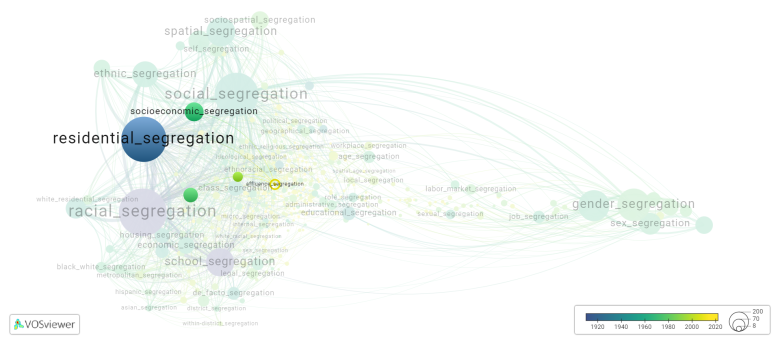Affluence segregation: Difference between revisions
(Creating page) |
(Creating page) |
||
| (8 intermediate revisions by the same user not shown) | |||
| Line 1: | Line 1: | ||
===== Date and country of first publication<ref>Date and country of first publication as informed by the Scopus database (December 2023).</ref>===== | |||
2019<br> | 2019<br> | ||
United States | United States | ||
===== Definition ===== | |||
Affluence segregation refers to the practice of separating individuals or communities based on their level of wealth or income. It often leads to the creation of affluent neighborhoods or gated communities that are exclusively inhabited by high-income residents, while low-income individuals are concentrated in lower-income neighborhoods or areas with fewer resources. | Affluence segregation refers to the practice of separating individuals or communities based on their level of wealth or income. It often leads to the creation of affluent neighborhoods or gated communities that are exclusively inhabited by high-income residents, while low-income individuals are concentrated in lower-income neighborhoods or areas with fewer resources. | ||
| Line 13: | Line 12: | ||
Efforts to address affluence segregation often focus on promoting affordable housing options, improving access to quality education and healthcare for disadvantaged communities, and creating policies that encourage socioeconomic diversity in neighborhoods. These actions aim to create more inclusive and equitable communities where people from different income groups can live, work, and interact with one another. | Efforts to address affluence segregation often focus on promoting affordable housing options, improving access to quality education and healthcare for disadvantaged communities, and creating policies that encourage socioeconomic diversity in neighborhoods. These actions aim to create more inclusive and equitable communities where people from different income groups can live, work, and interact with one another. | ||
==See also== | ==See also== | ||
==Related segregation forms== | |||
Affluence segregation is frequently discussed in the literature with the following segregation forms: | |||
[[residential segregation]], [[income segregation]], [[socioeconomic segregation]], [[poverty segregation]] | |||
[[File:affluence_segregation.png|780x780px]] | |||
This visualization is based on the study [[Segregation_Wiki:About| The Multidisciplinary Landscape of Segregation Research]]. | |||
For the complete network of interrelated segregation forms, please refer to: | |||
* [https://tinyurl.com/2235lkhw First year of publication] | |||
* [https://tinyurl.com/2d8wg5n3 Louvain clusters] | |||
* [https://tinyurl.com/223udk5r Betweenness centrality] | |||
* [https://tinyurl.com/244d8unz Disciplines in which segregation forms first emerged (Scopus database).] | |||
==References== | ==References== | ||
==Notes== | ==Notes== | ||
<references /> | <references /> | ||
== | {{NoteAI}} | ||
==Affluence segregation appears in the following literature== | |||
Yavaş M. (2019) | Yavaş M. (2019). Dissecting income segregation: Impacts of concentrated affluence on segregation of poverty. ''Journal of Mathematical Sociology'', ''43''(1), 1-22. Routledge.https://doi.org/10.1080/0022250X.2018.1476858 | ||
Haandrikman K. | Haandrikman K., Costa R., Malmberg B., Rogne A.F., Sleutjes B. (2021). Socio economic segregation in European cities. A comparative study of Brussels, Copenhagen, Amsterdam, Oslo and Stockholm. ''Urban Geography'', -. Routledge.https://doi.org/10.1080/02723638.2021.1959778 | ||
Latest revision as of 07:17, 16 October 2024
Date and country of first publication[1][edit | edit source]
2019
United States
Definition[edit | edit source]
Affluence segregation refers to the practice of separating individuals or communities based on their level of wealth or income. It often leads to the creation of affluent neighborhoods or gated communities that are exclusively inhabited by high-income residents, while low-income individuals are concentrated in lower-income neighborhoods or areas with fewer resources.
This form of segregation can perpetuate socioeconomic inequality as it limits access to opportunities such as quality education, healthcare, and employment for low-income individuals. It can also reinforce social and cultural divides, as people from different socioeconomic backgrounds have limited interactions and less understanding of each other's experiences.
Affluence segregation can also have negative societal implications. It can result in the uneven distribution of resources and services, further exacerbating the disparities between rich and poor communities. It can also lead to social isolation and the development of homogenous communities that lack diversity in terms of income, race, and ethnicity.
Efforts to address affluence segregation often focus on promoting affordable housing options, improving access to quality education and healthcare for disadvantaged communities, and creating policies that encourage socioeconomic diversity in neighborhoods. These actions aim to create more inclusive and equitable communities where people from different income groups can live, work, and interact with one another.
See also[edit | edit source]
Related segregation forms[edit | edit source]
Affluence segregation is frequently discussed in the literature with the following segregation forms:
residential segregation, income segregation, socioeconomic segregation, poverty segregation

This visualization is based on the study The Multidisciplinary Landscape of Segregation Research.
For the complete network of interrelated segregation forms, please refer to:
References[edit | edit source]
Notes[edit | edit source]
- ↑ Date and country of first publication as informed by the Scopus database (December 2023).
At its current state, this definition has been generated by a Large Language Model (LLM) so far without review by an independent researcher or a member of the curating team of segregation experts that keep the Segregation Wiki online. While we strive for accuracy, we cannot guarantee its reliability, completeness and timeliness. Please use this content with caution and verify information as needed. Also, feel free to improve on the definition as you see fit, including the use of references and other informational resources. We value your input in enhancing the quality and accuracy of the definitions of segregation forms collectively offered in the Segregation Wiki ©.
Affluence segregation appears in the following literature[edit | edit source]
Yavaş M. (2019). Dissecting income segregation: Impacts of concentrated affluence on segregation of poverty. Journal of Mathematical Sociology, 43(1), 1-22. Routledge.https://doi.org/10.1080/0022250X.2018.1476858
Haandrikman K., Costa R., Malmberg B., Rogne A.F., Sleutjes B. (2021). Socio economic segregation in European cities. A comparative study of Brussels, Copenhagen, Amsterdam, Oslo and Stockholm. Urban Geography, -. Routledge.https://doi.org/10.1080/02723638.2021.1959778
